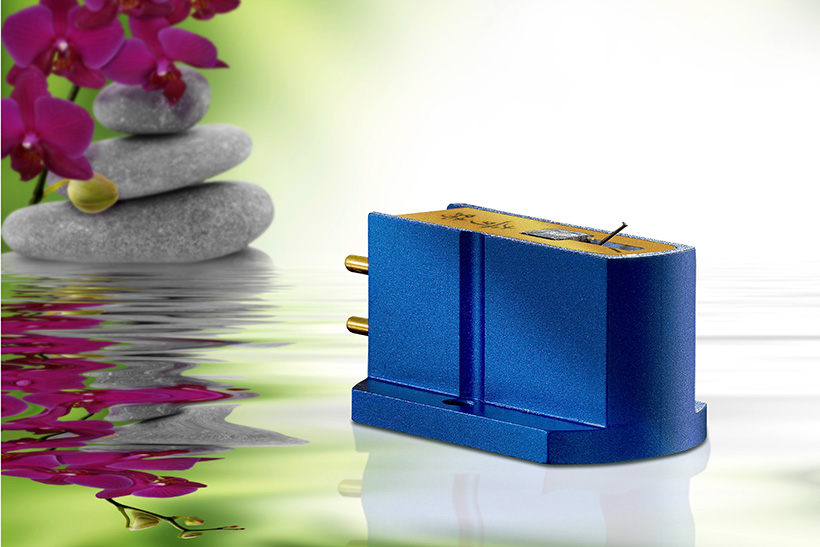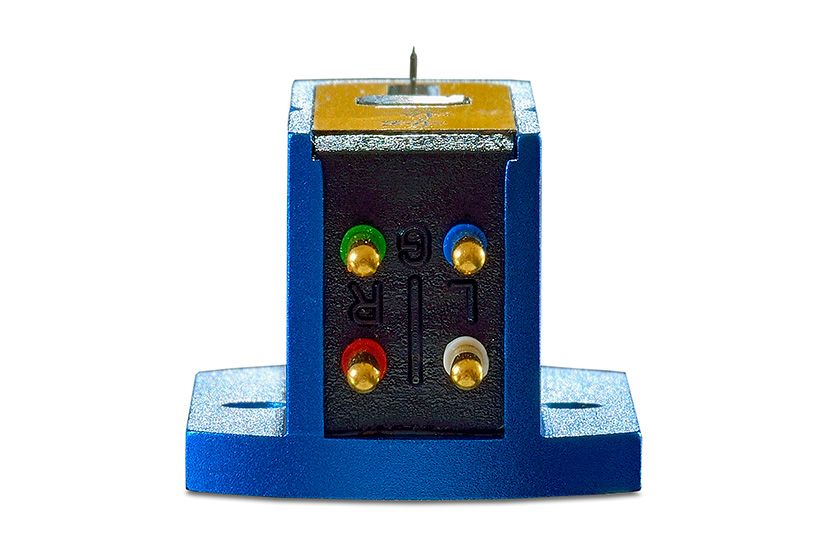The waiting is over, a classic Japanese cartridge is back in full production after a twenty year hiatus. René finds out that it more than lives up to the brand’s reputation?
Kiseki is the Japanese word for miracle, Kiseki is also a cartridge brand owned by Durob Audio in the Netherlands. Durob Audio was once a leading distributor of Koetsu cartridges in the days when vinyl was king. When Koetsu made a drastic change to its distribution policy Durob Audio developed its own cartridge in Japan and soon the Kiseki range became famous. In those days almost no one knew that Durob Audio owner Herman van den Dungen was behind the brand.
These and more stories can be found on the Kiseki website now that production, which has been on hold since the nineties, has started again. A batch of a 100 NOS (new old style) Kiseki Blues were made from old leftover parts recently and the speed with which they sold inspired the company to come up with the Blue New Style. Said to be an even better cartridge than the Blue NOS and available in quantities only limited by production speed. The length of the body has changed for an easier fit in most arms, the rest of the design remains the same, although the parts have far closer tolerances than they used to. The body is made from aluminium alloy and is 25mm long and weighs 10 grams, which combined with a dynamic compliance of 16 µm/nM means a medium mass tone arm will be the best match. The solid boron cantilever is tipped with a nude line-contact diamond stylus that is mirror polished. The VTA is 20 degrees and the recommended tracking force is a higher than average 2.4 grammes.

The Kiseki was fitted into a Transrotor/SME 5009 arm (the 5009 is a combination of the SME V bearing and a 300 series arm tube), mounted on a Transrotor Super Seven turntable. The standard VdH silver cable is fitted with XLR plugs to enjoy the balanced input on a HAT tube phono stage with Lundahl input transformers. The input impedance is 100 Ohms but the Kiseki Blue NS prefers 400 Ohm for best results. I don’t consider this to be a problem but am aware that a higher impedance will make the sound a bit more forward and bright. If this were my own cartridge I would get the impedance changed to suit. The next step in the system is an Audia Flight Strumento No.1 preamp feeding a pair of PrimaLuna DiaLogue Premium HP power amplifiers. Each one filled with eight KT-120 tubes and switched to monoblock operation. Loudspeakers are my trusted PMC fact.12s. All the hardware save the power amps are fed by a PS Audio P5 Power Plant. Most cabling is by Crystal Cable.
After an extended run in period, a period that only took so long because I hated to see the Kiseki go back, I decided to enlighten my morning with some compositions by Bach. The Brandenburg Concertos played by the Academy of St. Martin-in-the-Fields and according to the label released in 1971. This shows the Kiseki’s ability to reveal subtlety of harmonic structure and the body to add power when the composer demands. The quality of solo violin brings great joy and makes the music fully involving. Its character is made clear, as is the way Iona Brown becomes one with the instrument. When the orchestra fills the room soon after, a complete concert stage appears right in front of me. There’s never a dull moment, nor any trace of strain, harshness or overpowered bass. The cartridge seems to have no character of its own, it becomes one with the artist and produces the original performance no matter what you play. The sopranino recorders on Concerto No. 4 have a very natural sound and show the Kiseki’s dynamic capabilities. This is not my favourite part in this recording because at higher volumes the flutes become overwhelming and I have to restrain myself from turning the volume down, but it shows the excellent tracking of the Blue NS at high frequencies. I know other cartridges that can get nasty with this concert, or add a lot of distortion. Turning to the imaging the Kiseki throws open a soundstage that reaches outside the loudspeakers to the left and right, but adds more to depth and height than to width. On this particular Bach recording this character means that the musicians perform like they are sitting not too far away each other. The pictures in the booklet that comes with the Bach box show this is exactly the case.

If you want to be impressed listen to the Gian Carlo Menotti Concert in F for piano and orchestra on a limited edition Analogue Productions record. Earl Wild plays into AKG C-12 microphones feeding a 3-track Ampex 300 Series vacuum tube recorder. What is captured is the enormous dynamic range an orchestra adds to a tenderly played solo piano. Again and again the piano sounds only natural and clear. When the power of the orchestra joins in a lot of cartridges give up and make a mess of the orchestra. Not the Kiseki, most musicians and most instruments remain individual parts of the whole picture. This done with so much ease that you wonder why CD was ever invented (possibly because most people hadn’t the sense to buy a great turntable and a Kiseki, Ed.).
The Supex connection
Looking for more piano in my record collection The Köln Concert by Keith Jarrett pops up. Part One is among the most captivating piano works I have heard and I have played it too many times on numerous turntables, phono preamps and cartridges, which is the reason I had to replace the record with a new one when I found an original sealed copy. The Kiseki is very good at reproducing the acoustics of the concert hall, some cartridges sound too direct, offering only the grand piano and some part of the stage. Not the Kiseki, it earns my respect by revealing the ambient signature of the venue. Jarrett’s pounding feet are very clear too, the cartridge has enough weight to make the pounding sound very real. This seems so easy but it is not, you need a cartridge that has real bass extension and the ability to separate the details in the lower registers. Most important is of course the grand piano itself, this is powerful, more powerful than I have heard in a long time. It somehow reminds me of why I bought a Supex MC cartridge in 1977, the only cartridge in those days that really had enough power to kick my Rogers transmission lines into action. Many years have gone by since I had that combination but it was an experience I will never forget. The Supex is long gone, just like the Rogers, so it seems amazing to find a Kiseki that has some of the Supex’s properties and to play it through modern transmission lines. This combination that keeps me playing the Jarrett recording over and over. For those unfamiliar with Supex, their 900 SD cartridges were made by the later owner of Koetsu. We should not forget the past, on the other hand new materials and far better production techniques lead to better products, as is clearly shown by Kiseki in the form of the Blue NS.
I could play a lot of female singers to assess this cartridge but I choose Stacey Kent and the late Eva Cassidy. Dreamsville by Ms. Kent is one of those records that warms you inside. Play it late at night to finish your brandy with, at a low volume with dimmed lights and soon you will be in your own dreams(ville). In the daytime at a higher volume I am surrounded by the lovely voice and the sensitive playing. But we are not talking about Stacey Kent, it is the Blue NS that needs further attention. Listen to the guitar, the brushed cymbals, the tight bass or the saxophone and you soon forget your day to day worries. Just as with classical the harmony between instruments (and voice for that matter) is exciting, they don’t sound too soft or compressed, they just sound so natural and expressive. Stacey is singing just for you, addressing you personally, having you and only you in mind when she sings “Isn’t it a pity we never met before”. The environment of a jazz café comes to mind, the singer close to the piano, musicians doing their utmost to engage the audience. Just close your eyes and the Kiseki will take you there.

This cartridge is pure, distortion free and one of the best trackers that ever came my way. To wake up from my daydreams I swap Stacey for Eva and move on. Fields of Gold starts to play, the angelic voice reaches deep into your soul when it’s played with such purity. Not a single note is missed, not the tiniest crackle appears from the black surface of the vinyl, not the slightest harshness, dullness or other nastiness reaches the listener. Background voices on the next track mix easily with Eva’s voice, a Hammond organ leading the way, trumpet coming up and congas in the rhythm section. Autumn Leaves fits in perfectly with the reality outside my window. Maybe this is a good time for me to put away the keyboard that turns my typing into words, words that can hardly describe how much I enjoy this cartridge. It might not be perfect, but it comes close enough, and reason for a firm recommendation if your system is good enough to reveal its qualities. Me? I will enjoy my records as long as Herman van den Dungen will let me hold onto this little blue gadget. I have to leave you right now to fetch more and more records from my collection.
Overwhelmingly happy
Long ago, before Sony and Philips took over with CD, turntables were fitted with cartridges at a range of prices. A lot of which came from Japan, others from Europe and some from the USA. Customers could even try cartridges at home at the risk of damaging the stylus or cantilever. Nowadays most hi-fi shops stock turntables because vinyl is popular again, but do not offer the possibility to listen to a wide range of cartridges. Or course some still offer this service, but mostly you need to turn to reviews to make a shortlist to choose from. Fortunately most modern cartridges will perform nicely and track well with new and old vinyl. But finding that special one that makes you overwhelming happy and shows you why you once bought the records in your collection, is one hell of a job. To make life a little easier Kiseki has returned to the market to offer an outstanding cartridge that preserves the qualities of the past, thanks to the history of its maker, and combines this with today’s modern production standards and materials.
Regardless of what kind of music you like, the Kiseki Blue NS will handle it with an ease not often found at this price level. My formal conclusion can only be that the Kiseki range, brought back to life in an expanding market for vinyl and turntables, is a great addition to that same market. After this cartridge had seen enough record sides to be fully run in and expose all its capabilities it became harder and harder to send it back to Durob Audio. Firmly recommended without any hesitation.


